     
This was our 1966 Austin Healey Sprite. This car is a lot of fun
to drive even though it has only about 35 horsepower. We sold this
one in 2006.
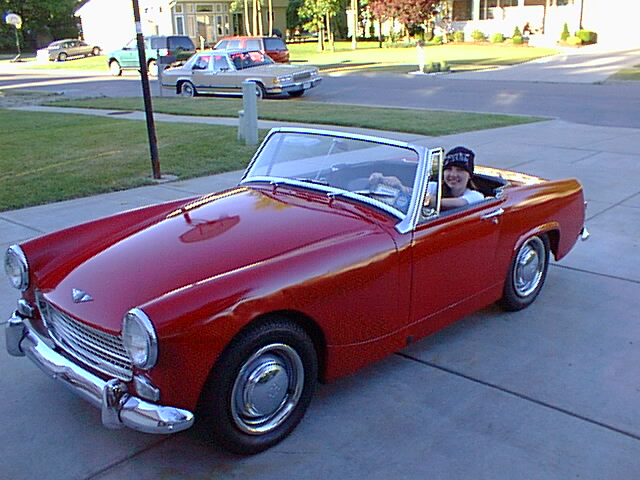
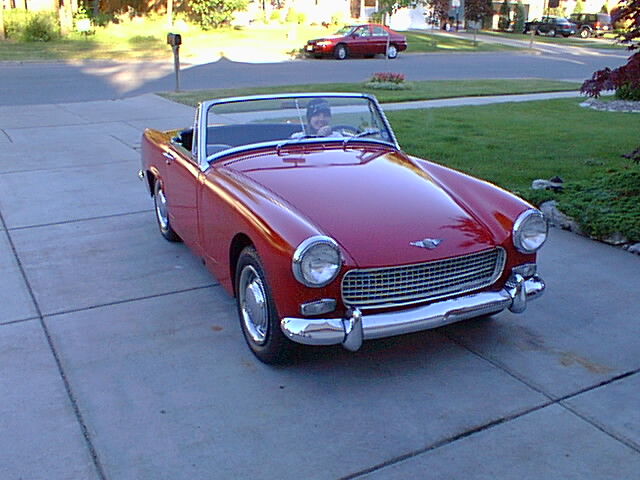
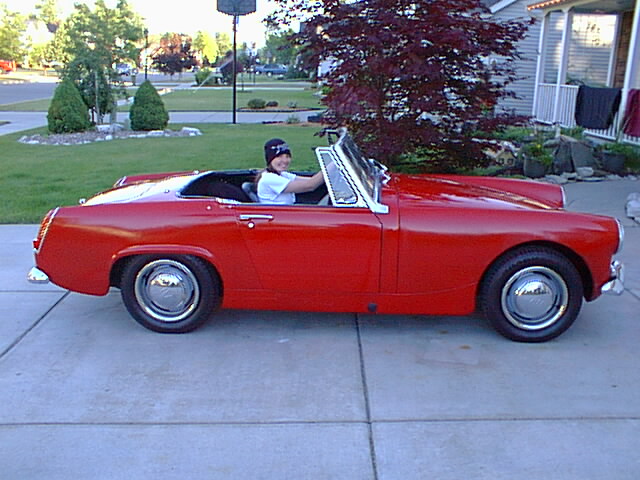
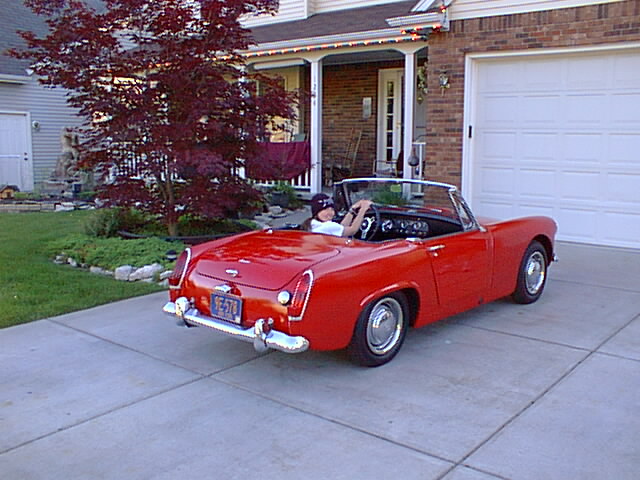
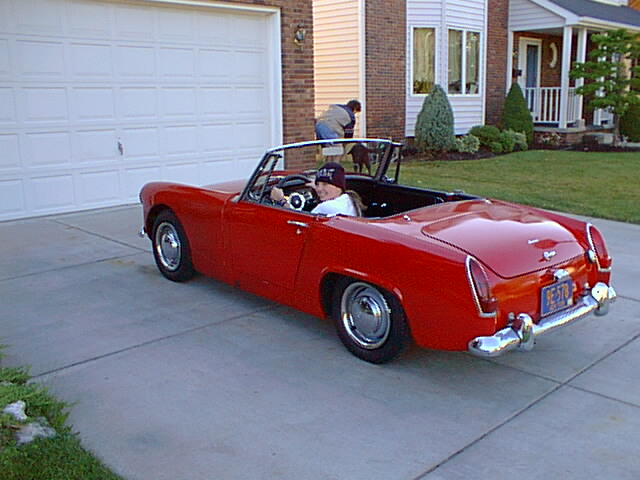
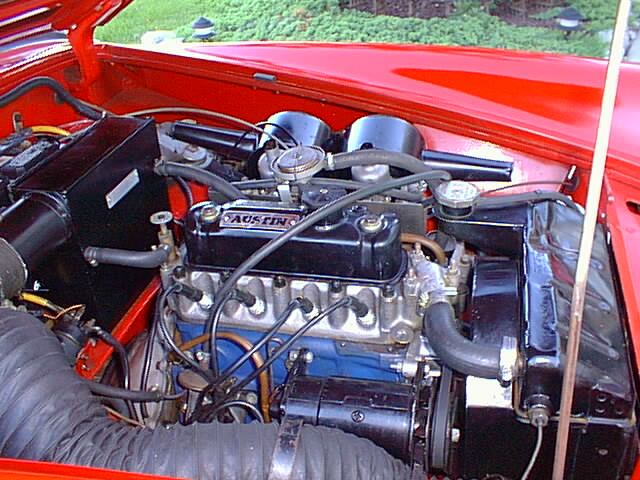
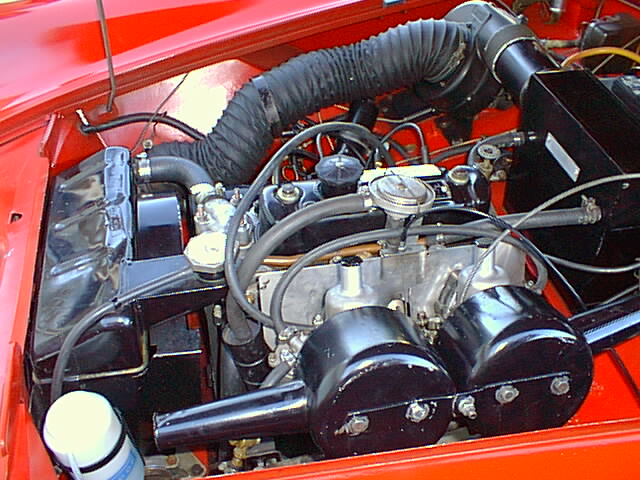
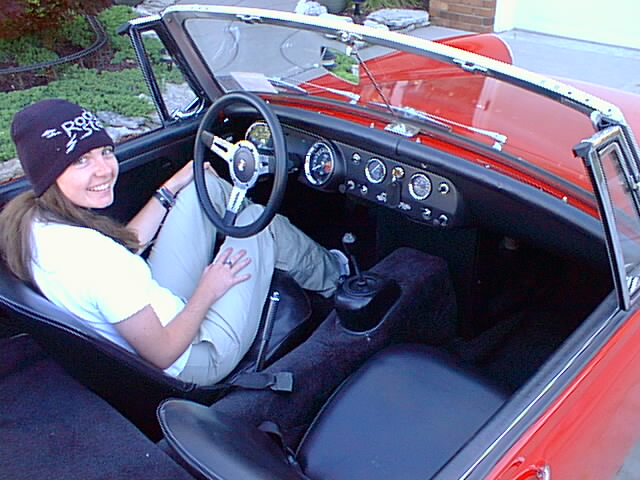
Here is some Austin Healey Sprite Information:
 In
1958 the BMC publicity department announced the new Austin Healey Sprite. A
small, low cost sports car designed to fill the hole in the market left by the
small pre-war Austin seven sports cars. The car was designed by the Healey motor
company within the bounds of their partnership with BMC. It was designed to use
as many parts from the corporate parts bin as possible. Most came from the A35;
front suspension, engine, gearbox and back axle. The steering rack was that used
on the Morris Minor. This use of off the shelf parts helped keep the development
costs to a minimum, thereby satisfying the need that the car should be cheap to
put into production. The initial plan was to produce a car which had identical
front and rear panels thereby saving tooling costs. This ideal was however to
prove too impractical but perhaps explains the similarity in lines between the
front and rear paneling on the mark I sprite. In
1958 the BMC publicity department announced the new Austin Healey Sprite. A
small, low cost sports car designed to fill the hole in the market left by the
small pre-war Austin seven sports cars. The car was designed by the Healey motor
company within the bounds of their partnership with BMC. It was designed to use
as many parts from the corporate parts bin as possible. Most came from the A35;
front suspension, engine, gearbox and back axle. The steering rack was that used
on the Morris Minor. This use of off the shelf parts helped keep the development
costs to a minimum, thereby satisfying the need that the car should be cheap to
put into production. The initial plan was to produce a car which had identical
front and rear panels thereby saving tooling costs. This ideal was however to
prove too impractical but perhaps explains the similarity in lines between the
front and rear paneling on the mark I sprite.
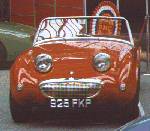 The
initial body styling was by Gerry Coker and The initial design incorporated
headlights which pivoted up into position like the Porsche 928. This radical
idea had to be dropped because of the difficulty of producing a cheap and
reliable mechanism to move the light units into place. Gerry left the Healey
Motor company in 1957 and his successor Les Ireland, finished off the design
with the fixed upright lighting arrangement with which the car went into
production. this arrangement of the lighting gave the car its frog like
appearance and led to the mark I becoming affectionately known as the frogeye,
(or bugeye in the USA). When first launched the car cost £660 including tax in
the UK and $1,795 at East Coast POE in the USA. The car was produced at the MG
factory in Abingdon alongside the larger Austin Healeys and the current MG
product range. The original plan was to produce the car at Austin's plant at
Longbridge but the design of the Sprite made it impossible to fit the power
train from underneath the car and the MG factory was the only plant available to
BMC at the time which could fit the units from above. In all around 49,500 mark
I Sprites were built. The
initial body styling was by Gerry Coker and The initial design incorporated
headlights which pivoted up into position like the Porsche 928. This radical
idea had to be dropped because of the difficulty of producing a cheap and
reliable mechanism to move the light units into place. Gerry left the Healey
Motor company in 1957 and his successor Les Ireland, finished off the design
with the fixed upright lighting arrangement with which the car went into
production. this arrangement of the lighting gave the car its frog like
appearance and led to the mark I becoming affectionately known as the frogeye,
(or bugeye in the USA). When first launched the car cost £660 including tax in
the UK and $1,795 at East Coast POE in the USA. The car was produced at the MG
factory in Abingdon alongside the larger Austin Healeys and the current MG
product range. The original plan was to produce the car at Austin's plant at
Longbridge but the design of the Sprite made it impossible to fit the power
train from underneath the car and the MG factory was the only plant available to
BMC at the time which could fit the units from above. In all around 49,500 mark
I Sprites were built.
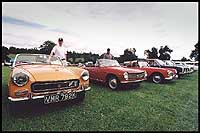 1961
saw the introduction of the replacement for the Sprite Mk I, the car had
undergone a major restyling. The front end was restyled by Healeys at Warwick
along more traditional lines: the one piece front end of the frogeye was gone,
being replaced by a more traditional layout of fixed front wings and a separate
bonnet. The rear end of the car was re-styled by Syd Enever's team at MG and
closely resembled the embryonic MGB. It is still unclear why BMC asked the two
design teams to work on styling different parts of the same vehicle and
specifically instructed MG not to talk to Healeys about what they were doing.
However, with the two teams based in such close proximity to each other they
very soon got together to ensure that the changes being made would agree when
brought together on the same vehicle. One can only speculate as to the outcome
if these two teams had not colluded on their design work. Mechanically the mark
II sprite was almost identical to the mark I although the engine was slightly
tuned to handle the extra body-weight of the new car. One month after the
introduction of the Sprite Mk II an MG badged version was released, taking its
name from the pre-war small MG's it was called the Midget. 1961
saw the introduction of the replacement for the Sprite Mk I, the car had
undergone a major restyling. The front end was restyled by Healeys at Warwick
along more traditional lines: the one piece front end of the frogeye was gone,
being replaced by a more traditional layout of fixed front wings and a separate
bonnet. The rear end of the car was re-styled by Syd Enever's team at MG and
closely resembled the embryonic MGB. It is still unclear why BMC asked the two
design teams to work on styling different parts of the same vehicle and
specifically instructed MG not to talk to Healeys about what they were doing.
However, with the two teams based in such close proximity to each other they
very soon got together to ensure that the changes being made would agree when
brought together on the same vehicle. One can only speculate as to the outcome
if these two teams had not colluded on their design work. Mechanically the mark
II sprite was almost identical to the mark I although the engine was slightly
tuned to handle the extra body-weight of the new car. One month after the
introduction of the Sprite Mk II an MG badged version was released, taking its
name from the pre-war small MG's it was called the Midget.
It wasn't until 1962 that
mechanical changes were to follow: The Morris Minor 1098cc engine was fitted
along with a stronger gearbox, an electronic tachometer, front disc brakes and a
host of other small detail changes. This model known at the time as the Sprite
1100 has come to be known as the mark II 1/2. The mark III designation was to be
saved until 1964.
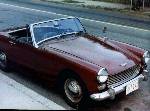 The
Sprite Mk III retained essentially the same styling as the mark II but the
engine was carefully scrutinized and modified after the serious crankshaft
problems encountered on the mark II. More notably there was a major change to
the rear suspension arrangement: The earlier Sprites had used an innovative
design with quarter elliptic springs and trailing location arms, whilst an
exiting concept the original arrangement was often accused of being somewhat
twitchy when driven hard. The half elliptic arrangement which replaced it gave a
smoother ride without any loss of the Sprite's by now legendary road holding
power. An innovative piece of design work saw wind up windows shoe-horned into
the slim-line doors of the mark III replacing the more traditional removable
sidescreens of the earlier models. The cockpit was revamped to bring the styling
more up to date and the now familiar black crinkle finish dash appeared for the
first time. An interesting point to note is that this is the only model of
Sprite to be fitted with color keyed hoods from the factory, so that red cars
(for example), had red hoods. The
Sprite Mk III retained essentially the same styling as the mark II but the
engine was carefully scrutinized and modified after the serious crankshaft
problems encountered on the mark II. More notably there was a major change to
the rear suspension arrangement: The earlier Sprites had used an innovative
design with quarter elliptic springs and trailing location arms, whilst an
exiting concept the original arrangement was often accused of being somewhat
twitchy when driven hard. The half elliptic arrangement which replaced it gave a
smoother ride without any loss of the Sprite's by now legendary road holding
power. An innovative piece of design work saw wind up windows shoe-horned into
the slim-line doors of the mark III replacing the more traditional removable
sidescreens of the earlier models. The cockpit was revamped to bring the styling
more up to date and the now familiar black crinkle finish dash appeared for the
first time. An interesting point to note is that this is the only model of
Sprite to be fitted with color keyed hoods from the factory, so that red cars
(for example), had red hoods.
In October 1966 the Sprite Mk IV
was announced, the engine was the newer 1275cc A series unit giving much more
power for a car that was becoming comparatively sluggish. the MG variant (by now
at Mark III) had lost it's distinctive chrome strip down the center of the
bonnet and the distinction between the two models was becoming noticeable less
prevalent. The mark IV also sported an improved folding hood to replace the
older removable hoods on previous models. Within three years the beginning of
the end for the Sprite was in sight, the Austin Healey models were no longer to
be exported to the USA, only the MG models were exported taking advantage of the
more popular MG name.
 October
1969 saw a facelift operation on both the Sprite and the Midget: Rostyle wheels,
black sills, slim-line bumpers accompanied major trim changes. Now the only
difference between the two models was the badges, from a distance it was
impossible to tell the MG Midget from the AH Sprite. although these changes
radically altered the look of both the Sprite and the Midget BMC did not assign
a new mark designation; they remained as the mark IV and III respectively.
However, they have been unofficially dubbed later as the mark V Sprite and mark
IV Midget to distinguish them from the earlier versions with the same mark
designation. October
1969 saw a facelift operation on both the Sprite and the Midget: Rostyle wheels,
black sills, slim-line bumpers accompanied major trim changes. Now the only
difference between the two models was the badges, from a distance it was
impossible to tell the MG Midget from the AH Sprite. although these changes
radically altered the look of both the Sprite and the Midget BMC did not assign
a new mark designation; they remained as the mark IV and III respectively.
However, they have been unofficially dubbed later as the mark V Sprite and mark
IV Midget to distinguish them from the earlier versions with the same mark
designation.
By 1971 BMC had gone, swallowed up
in a take-over to form the ill fated British Leyland, significantly the rival
company Triumph was now part of the same corporation as Austin and MG. The
agreement with the Healey Motor Company ended, and the Healeys did not feel that
they could work with BL in the same manner that they had with BMC so no new
agreements were sought. The license on the use of the Healey name ended with the
original BMC agreement so BL had to remove the Healey name from the Sprite. From
January 1971 the Sprite was know as simply the Austin Sprite and was simply a
stop gap whilst the Austin dealer franchises were re-negotiated to allow them to
sell MG models. Only 1,022 Austin Sprites were made before sadly the last Sprite
left Abingdon in July 1971, representing the last of a line of 129,362 cars.
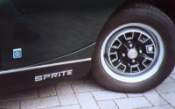 Production
of the MG Midget continued with a change to the cockpit switch-gear replacing
the original toggle switches with those of a rocker type to meet US legislation.
The rear wheel arches were changed to a round section instead of the original
square Enever design evident from the mark II Sprite onwards. Production
of the MG Midget continued with a change to the cockpit switch-gear replacing
the original toggle switches with those of a rocker type to meet US legislation.
The rear wheel arches were changed to a round section instead of the original
square Enever design evident from the mark II Sprite onwards.
Major controversial changes due to
meet new US legislation were to appear on the MG Midget in October 1974: The
ride height was increased, the front and rear ends of the car sprouted
heavyweight rubber coated bumpers and perhaps most controversial to the die hard
MG purists there was now a Triumph power unit under the bonnet in the form of
the 1500 Spitfire engine. the gearbox was now an all synchromesh unit as used on
the Morris Marina. These changes helped to reverse the sales decline of the
Midget and sales rose until 1976. Only three years later however Michael Edwards
(by now in charge of BL), announced that sportscar production at Abingdon would
cease and the MG factory would close.
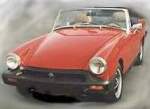 The
Midget continued until 1979, the last car to roll off the production line at
Abingdon was a appropriately colored black and went straight into the BL
Heritage collection (now owned by British Motor Heritage). The total number of
MG Midgets produced by close of business at Abingdon was 226,526 giving a
combined total of 355,888 "Sprites" in all. It is interesting to note
that despite the various changes to the Sprite over its 21 year production the
basic chassis remained the same, the only modifications were to the rear
suspension mountings and the addition of extra strengthening when the rubber
bumpers were added. On the very last Midget the front end of the sill still
retained the radiused kick up for the one piece frogeye bonnet. The
Midget continued until 1979, the last car to roll off the production line at
Abingdon was a appropriately colored black and went straight into the BL
Heritage collection (now owned by British Motor Heritage). The total number of
MG Midgets produced by close of business at Abingdon was 226,526 giving a
combined total of 355,888 "Sprites" in all. It is interesting to note
that despite the various changes to the Sprite over its 21 year production the
basic chassis remained the same, the only modifications were to the rear
suspension mountings and the addition of extra strengthening when the rubber
bumpers were added. On the very last Midget the front end of the sill still
retained the radiused kick up for the one piece frogeye bonnet.
| ![]()